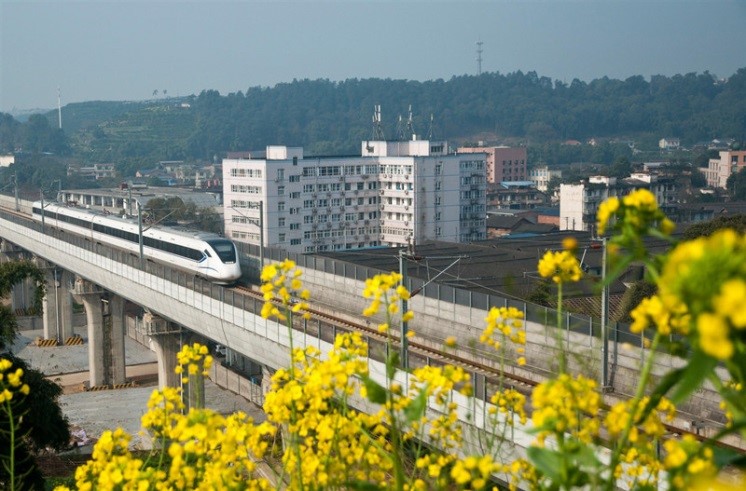


On March 10, 2019, on the outskirts of Pujiang County, Sichuan, the China Railway High-speed (CRH) drove past the village full of flowers. Chengya Railway, a section of the Sichuan-Tibet Railway, has been running through the whole line. (Photo by Zhu Chunjian from People’s Daily Online)
Construction work on the final section of the Sichuan-Tibet Railway will start shortly, said Southwest China’s Sichuan Province Party chief during a press conference at the State Council Information Office (SCIO) on Monday, June 17. Analysts said the railway will serve as a major transportation artery linking China and South Asia.
The Chengdu-Ya’an section of the Sichuan-Tibet Railway has started operations, said Peng Qinghua, Party chief of Sichuan Province.
“The completion of the railway will not only drive the regional economy and strengthen the link between Tibet with the inland areas, but it also can serve as a major transportation artery linking China and South Asia,” Zhao Jian, an expert on railway economics at the Beijing Jiaotong University, told the Global Times on June 17.
“The Sichuan-Tibet railway will make it possible to build a railway connecting China, Nepal, India and other countries, which will boost the regional economy with convenient transportation,” Zhao said.
“Sichuan was the starting point of the southern silk road in history. Now it is the pivot of the Belt and Road Initiative economy belt, linking land and sea,” said Peng.
The Sichuan-Tibet Railway will be the second line linking Southwest China’s Tibet Autonomous Region to other parts of China after the Qinghai-Tibet Railway.
The line is designed to start from Chengdu, capital of Sichuan Province, passing through Ya’an and entering Tibet via Qamdo. It will then go through Nyingchi prefecture and end at Lhasa, capital of Tibet.
The Lhasa-Nyingchi section is under construction, said Peng. “The 1,000-kilometer Ya'an-Nyingchi section is part of the plan. Bridges and tunnels will cover over 90 percent of the line, that is to say, nearly 800 kilometers of tunnels and 100 kilometers of bridges.”
“It is far more difficult to build the Sichuan-Tibet Railway than the Qinghai-Tibet Railway since geological conditions are complex along the Sichuan-Tibet line, with severe geological conditions and disasters such as permafrost, alpine hypoxia, landslides, earthquake zones, and geothermal and rock bursts,” Zhao added.
The planned route will go through the Sichuan basin, Yunnan-Guizhou Plateau and Qinghai-Tibet Plateau, climbing from several hundred meters above sea level to the “Roof of the World,” at an altitude of more than 4,400 meters.
The railway will cut the travel time from Chengdu to Lhasa from 48 hours to 13 hours.
 Fire brigade in Shanghai holds group wedding
Fire brigade in Shanghai holds group wedding Tourists enjoy ice sculptures in Datan Town, north China
Tourists enjoy ice sculptures in Datan Town, north China Sunset scenery of Dayan Pagoda in Xi'an
Sunset scenery of Dayan Pagoda in Xi'an Tourists have fun at scenic spot in Nanlong Town, NW China
Tourists have fun at scenic spot in Nanlong Town, NW China Harbin attracts tourists by making best use of ice in winter
Harbin attracts tourists by making best use of ice in winter In pics: FIS Alpine Ski Women's World Cup Slalom
In pics: FIS Alpine Ski Women's World Cup Slalom Black-necked cranes rest at reservoir in Lhunzhub County, Lhasa
Black-necked cranes rest at reservoir in Lhunzhub County, Lhasa China's FAST telescope will be available to foreign scientists in April
China's FAST telescope will be available to foreign scientists in April "She power" plays indispensable role in poverty alleviation
"She power" plays indispensable role in poverty alleviation Top 10 world news events of People's Daily in 2020
Top 10 world news events of People's Daily in 2020 Top 10 China news events of People's Daily in 2020
Top 10 China news events of People's Daily in 2020 Top 10 media buzzwords of 2020
Top 10 media buzzwords of 2020 Year-ender:10 major tourism stories of 2020
Year-ender:10 major tourism stories of 2020 No interference in Venezuelan issues
No interference in Venezuelan issues
 Biz prepares for trade spat
Biz prepares for trade spat
 Broadcasting Continent
Broadcasting Continent Australia wins Chinese CEOs as US loses
Australia wins Chinese CEOs as US loses